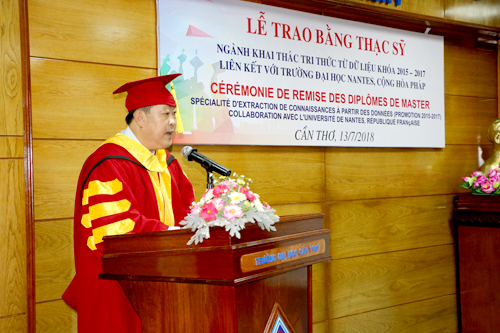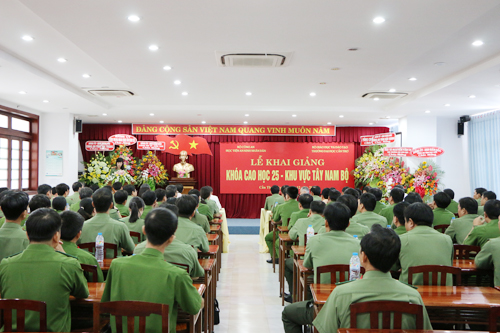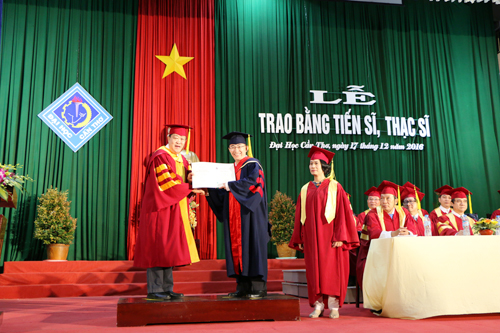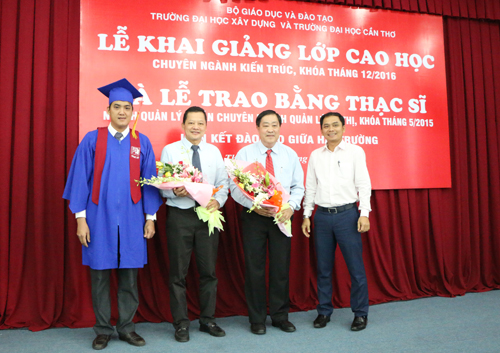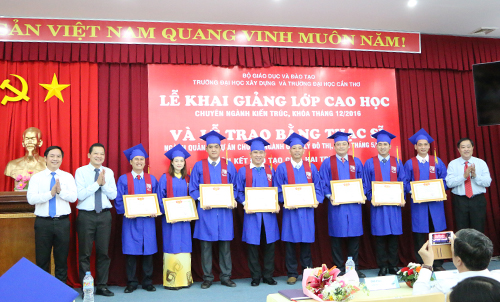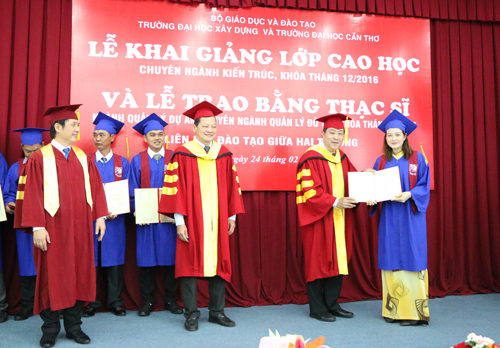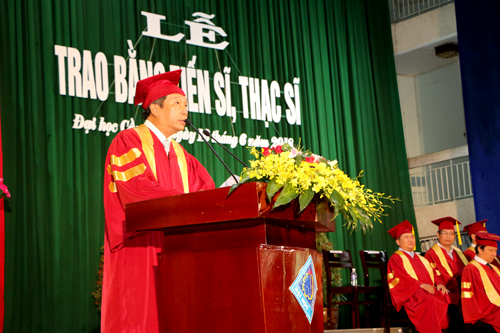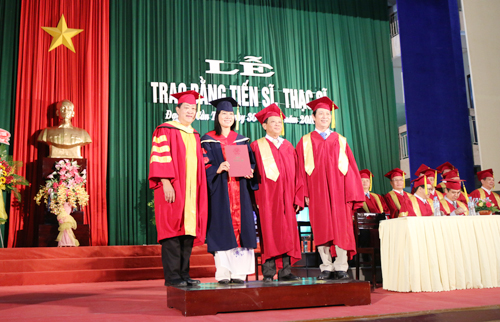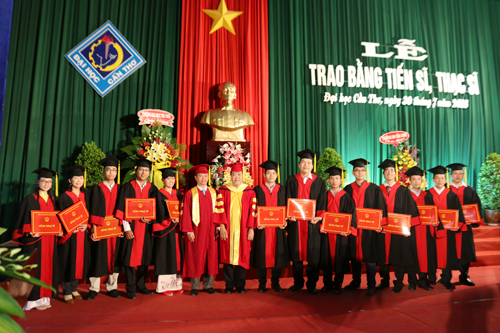
Tên đề tài: “Đặc điểm bệnh học của mầm bệnh Vibrio spp. và vi bào tử trùng hiện diện trong đường ruột ở tôm nước lợ ”.
Tác giả: Trương Minh Út, Khóa: 2016
Chuyên ngành: Nuôi trồng thủy sản; Mã số: 62620110. Nhóm ngành: Nông-Lâm-Ngư nghiệp
Người hướng dẫn chính: PGS.TS. Từ Thanh Dung - Trường Đại học Cần Thơ
- Tóm tắt nội dung luận án:
Trong những năm qua dịch bệnh đã và đang xảy ra nhiều trên tôm nuôi gây thiệt hại nghiêm trọng cho người nuôi tôm, điển hình là bệnh đường ruột do vi khuẩn Vibrio spp. và vi bào tử trùng Enterocytozoon hepatopanaei (EHP) gây ra. Nghiên cứu thu mẫu tổng số 378 mẫu từ 63 ao nuôi tôm thẻ chân trắng bệnh đường ruột tại 3 tỉnh Cà Mau (39 ao), Sóc Trăng (10 ao) và Bến Tre (14 ao). Tôm bệnh thường biểu hiện một số dấu hiệu bệnh lý điển hình liên quan đến gan tụy như sưng mềm, nhạt màu hoặc teo dai, nhạt màu cùng với các dấu hiệu đường ruột như ruột đứt khúc hoặc rỗng, phân lỏng và phân trắng.
Trên các mẫu tôm bệnh ghi nhận sự hiện diện của Gregrarine (14,29%), vi bào tử trùng EHP (41,27%) và vermiform (77,78%). Trong đó, tôm nhiễm EHP đặc trưng bởi các dấu hiệu như tôm chậm lớn, phân đàn trong ao kèm theo các biểu hiện mềm vỏ, đục cơ ốp thân gan tụy nhạt màu, teo, ruột rỗng và ruột có màu vàng nâu, phân lỏng. Các cụm bào tử EHP được phát hiện trên gan tụy tôm, các tiêu bản soi tươi và kính phết nhuộm giemsa, với 2 trạng thái tự do (ngoại bào) hoặc nằm bên trong tế bào chất biểu mô gan tụy.
Kết quả phân lập trên gan tụy và đường ruột tôm thu được tổng số 102 chủng vi khuẩn thuộc 5 loài Vibrio spp. xuất hiện với tỷ lệ 82,4% trên các mẫu tôm bệnh đường ruột thu từ các ao, trong đó tỷ lệ tôm bị đơn nhiễm 1 loài vi khuẩn và đa nhiễm từ 2 loài vi khuẩn tương ứng là 47,62% và 39,92%. Định danh dựa vào Kit test nhanh API 20E và giải trình tự gen 16S rRNA đã xác định được 5 nhóm Vibrio spp. trong đó V. alginolyticus chiếm tỷ lệ (50%), tiếp theo là V. cholerae với (17,7%) và thấp nhất là V. harveyi chiếm (5,9%).
Phân tích gen độc lực của một số chủng vi khuẩn Vibrio spp. trên tôm cho thấy hầu hết các loài vi khuẩn được phân tích có chứa ít nhất từ 1-3 gen độc lực; điển hình, cao nhất là V. parahaemolyticus BT1A1 có tới 03 gen độc lực (toxR, toxRS và pirB) và thấp nhất là V. alginolyticus có 01 gen độc lực là toxRS. Thí nghiệm xác định giá trị độc lực LD50 của vi khuẩn V. vulnificus CM3IC1 là 1,5×104 CFU/mL và V. parahaemolyticus BTIA1 là 2,7×105 CFU/mL. Trong khi đó, xác định độc lực vi khuẩn Vibrio spp. cảm nhiễm tổ hợp V. alginolyticus, V. cholerae, V. vulnificus (ACV); V. alginolyticus, V. cholerae, V. parahaemolyticus (ACP); V. alginolyticus, V. vulnificus, V. parahaemolyticus (AVP), V. cholerae, V. vulnificus, V. parahaemolyticus (CVP) và V. alginolyticus, V. cholerae, V. vulnificus, V. parahaemolyticus (ACVP) cho kết quả tỷ lệ chết của tổ hợp vi khuẩn theo thứ tự ACVP< ACP< ACV<AVP<CVP. Tôm ở 2 tổ hợp vi khuẩn ACV và ACP có biểu hiện bệnh lý tương tự tôm nhiễm hội chứng phân trắng ngoài tự nhiên.
Vi bào tử trùng EHP có khả năng lây truyền qua hình thức nuôi nhốt chung, nguồn nước nhiễm bào tử và đường tiêu hóa (cho ăn), trong đó lây truyền nhanh nhất được xác định ở hình thức nuôi nhốt chung giữa tôm bệnh và tôm khỏe ở ngày thứ 08, kế đến ngày thứ 10 ở nhiệm thức bổ sung bào tử EHP vào thức ăn và chậm nhất đối với thí nghiệm nguồn nước bổ sung bào tử EHP sau thời gian 14 ngày. Tôm cảm nhiễm EHP có biểu hiện bỏ ăn, mềm vỏ, còi cọc; khối gan tụy sưng, nhạt màu hoặc teo dai; đường ruột xoắn lò xo, đứt khúc có chứa dịch màu nâu đỏ. Trên gan tụy tôm thẻ chân trắng nhiễm EHP ghi nhận một số biến đổi trong cấu trúc biểu mô ống và sự hiện diện của EHP dưới dạng thể vùi nằm trong tế bào chất của tế bào biểu mô gan tụy cùng với các bào tử trưởng thành.
Chất chiết xuất từ diệp hạ châu (P. urinaria L) có hoạt tính kháng khuẩn mạnh nhất đối với hầu hết vi khuẩn Vibrio spp. gây bệnh trong điều kiện in - vitro. Bên cạnh đó, trong điều kiện In - vivo hỗn hợp kết hợp cao chiết lá ổi (P. guajava) và diệp hạ châu (P. urinaria L) cho hiệu quả tốt hơn cao chiết riêng lẻ, giúp nâng cao một số chỉ tiêu miễn dịch và khả năng phòng bệnh của tôm thẻ chân trắng đối với tổ hợp Vibrio spp. gây bệnh.
Từ khóa: Bệnh phân trắng, Enterocytozoon hepatopenaei (EHP), tôm thẻ chân trắng, Vibrio spp.
- Những kết quả mới của luận án:
Kết quả nghiên cứu có được 102 chủng vi khuẩn đã phân lập được từ 07 nhóm trong tổng số mẫu tôm thẻ chân trắng có dấu hiệu bị hội chứng phân trắng và chậm lớn được thu.
Trong nghiên cứu này lần đầu tiên nghiên cứu xác định được khả năng nhiễm kép của Vibrio spp. với tổ hợp vi khuẩn V. alginolyticus, V. cholerae, V. paraheamolyticus và V. vulnificus gây nên dấu hiệu bệnh đường ruột và phân trắng trên tôm thẻ chân trắng.
Nghiên cứu còn xác định được các con đường lây truyền của vi bào tử trùng qua 03 phương thức; nuôi nhốt chung, qua thức ăn và trong nước có bào tử EHP.
Đánh giá được hiệu quả về hoạt tính kháng khuẩn của cao chiết với 2 loại thảo dược diệp hạ châu (P. urinaria L) và lá ổi (P. guajva) đối với các loài Vibrio spp. Kết quả nghiên cứu đã xác định được hiệu quả của hỗn hợp thảo dược từ chiết xuất lá ổi và diệp hạ châu lên khả năng phòng bệnh đối với tổ hợp vi khuẩn đa loài Vibrio spp. gây bệnh đường ruột trên tôm thẻ chân trắng.
Tôm cảm nhiễm với tổ hợp V. alginolyticus, V. cholerae, V. vulnificus (ACV) và tổ hợp V. alginolyticus, V. cholerae, V. parahaemolyticus (ACP) gây biểu hiện bệnh lý hội chứng phân trắng tương tự như trên tôm bệnh thu ao nuôi đặc trưng với phân lỏng, đường ruột trắng, gan tụy sưng và nhạt màu.
- Các ứng dụng/khả năng ứng dụng trong thực tiễn, các vấn đề cần tiếp tục nghiên cứu:
Kết quả ghi nhận nghiệm thức bổ sung hỗn hợp cao chiết lá ổi và diệp hạ châu 1% (0,5% lá ổi: 0,5% diệp hạ châu) cho hiệu quả phòng bệnh tốt nhất với tỷ lệ chết thấp hơn đối chứng 17,5% và 7,5-10% khi so với nghiệm thức sử dụng thảo dược đơn. Kết quả này cũng tương ứng với hiệu quả được ghi nhận thông qua các chỉ tiêu miễn dịch (THC, PO) và tổng mật độ Vibrio spp. trong gan tuỵ và ruột.
Kết quả cho thấy tác động của hỗn hợp thảo dược khi mật số Vibrio spp. giảm thấp ở các nghiệm thức được bổ sung thảo dược nồng độ 500 mg/mL và 1000 mg/mL, kết quả cảm nhiễm với vi khuẩn Vibrio spp. cũng cho thấy hiệu quả phòng bệnh khi tỷ lệ chết ở các nghiệm thức bổ sung 500 mg/mL và 1000 mg/mL lần lượt là 90% và 50% khi so sánh với nghiệm thức đối chứng 100% tỷ lệ chết.
Kết quả nghiên cứu về sử dụng hỗn hợp thảo dược tạo cơ sở cho việc áp dụng các thử nghiệm về sau. Nhằm tăng cao hiệu quả của việc sử dụng thảo dược trong việc phòng và trị bệnh trên tôm thẻ chân trắng nói riêng và trong thuỷ sản nói chung. Việc sử dụng thảo dược dưới dạng hỗn hợp cũng giúp tiết kiệm chi phí sản xuất các cao chiết thô vì nguồn thảo dược hiện nay phục vụ cho ngành thuỷ sản nói chung còn nhiều hạn chế về số lượng và chất lượng. Ngoài ra, khi thảo dược được ứng dụng rộng rãi vào nuôi trồng thuỷ sản sẽ giúp hạn chế việc sử dụng kháng sinh, tránh được các rủi ro sau này do các đợt dịch bệnh bùng phát từ các vi khuẩn kháng kháng sinh và an toàn thực phẩm nhằm giúp ngành công nghiệp thuỷ sản phát triển bền vững trong nước và trên thị trường quốc tế.
Trong luận án này đã xác định con đường lây truyền vi bào tử trùng (EHP) qua hình thức nuôi nhốt chung rất có ý nghĩa trong ứng dụng dịch tễ học nhằm quản lý và kiểm soát bệnh phân trắng trên tôm thẻ chân trắng nuôi thâm canh.
Các vấn đề cần tiếp tục nghiên cứu:
Tiếp tục nghiên cứu về cơ chế gây bệnh và sự tương tác của các loài vi khuẩn trong tổ hợp vi khuẩn Vibrio spp. gây bệnh phân trắng trên thẻ chân trắng trong nghiên cứu.
Nghiên cứu về mối liên quan giữa các chủng Vibrio phân lập được và vi bào tử trùng trong khả năng gây bệnh đường ruột trên tôm.
Thesis title: “Pathological characteristics of the pathogen Vibrio spp. and microspores discovered in the gastrointestinal tract of brackish water”.
Major: Aquaculture Code: 62620301
Ph.D. student: Truong Minh Ut
Supervisor: Assoc. Prof. Tu Thanh Dung
Training Facility: Can Tho University
- Research Abstract
In recent years, diseases have been occurring on farmed shrimp, causing serious damage to shrimp farmers that is typical by the gastrointestinal tract caused by Vibrio spp. & Enterocytozoon hepatopenaei (EHP). A total of 378 samples were obtained from 63 ponds of white leg shrimp with the intestinal disease in three provinces: Ca Mau (39 ponds), Soc Trang (10 ponds), and Ben Tre (14 ponds). The infected shrimp frequently exhibit hepatopancreas-related pathological symptoms such as soft swelling, pale color or atrophy, pale color, as well as intestinal indicators such as broken or empty intestines, loose feces, and white feces.
The Gregrarine (14.29%), EHP microspores (41.27%), and vermiform (77.78%) were detected in infected shrimp samples. In particular, the EHP-infected shrimp is characterized by signs such as slow growth, size differences in ponds accompanied by the soft shell, opaque body shell, pale hepatopancreas, atrophy, empty intestines and yellow-brown intestines, and loose feces. Clusters of EHP spores were detected on shrimp hepatopancreas, biopsy specimens and Giemsa smears, with either free (extracellular) or intrahepatic epithelial cytoplasm.
The results of the bacteriological examination on the hepatopancreas and intestinal tract of shrimp isolated a total of 102 bacterial strains belonging to 5 Vibrio spp. species with an 82.4% rate on intestinal diseased shrimp samples collected from ponds, with the percentage of shrimp infected with single bacterial species and multiple infections being 47.62% and 39.92%, respectively. There are five groups of Vibrio spp., with V. alginolyticus accounting for 50% of them, V. cholerae for 17.7%, and V. harveyi for 5.9%, according to identification based on the API 20E Kit and 16S rRNA gene sequencing.
The results of virulence gene analysis of some Vibrio spp. strains in shrimp revealed that most of the analyzed bacterial species contained at least one to three virulence genes, with V. parahaemolyticus BT1A1 typically having the highest number with three (toxR, toxRS, and pirB), and V. alginolyticus having the lowest number with only one (toxRS). The LD50 virulence values of V. vulnificus CM3IC1 and V. parahaemolyticus BTIA1 were determined in the experiment as 1.5×104 CFU/mL and 2.7×105 CFU/mL, respectively. Determination of the virulence value of the Vibrio spp. mixture [V. alginolyticus, V. cholerae, V. vulnificus (ACV); V. alginolyticus, V. cholerae, V. parahaemolyticus (ACP); V. alginolyticus, V. vulnificus, V. parahaemolyticus (AVP), V. cholerae, V. vulnificus, V. parahaemolyticus (CVP) và V. alginolyticus, V. cholerae, V. vulnificus, V. parahaemolyticus (ACVP)] revealed the results of the mortality rate of the bacteria combinations in the order of ascending ACVP < ACP < ACV < AVP < CVP. Shrimp exposed to the bacterium ACV and ACP mixture in two different combinations exhibited comparable clinical signs to shrimp exposed to the white feces syndrome in the wild.
The EHP microspores can spread through co-culture, contaminated water, and the gastrointestinal system (feeding). The fastest transmission was determined on day 8 in the co-culture of infected and healthy shrimp, followed by day 10 in the treatment of adding EHP spores to the feed, and the slowest after 14 days in the water source experiment supplemented with EHP spores. Shrimp infected with EHP showed signs of anorexia, soft shell, stunted growth; swollen, pale, or atrophied hepatopancreas; Intestinal coil springs, broken, containing red-brown fluid. In the hepatopancreas of white leg shrimp infected with EHP found some changes in the tubular epithelial structure and the presence of EHP in the form of inclusions were found in the cytoplasm of hepatopancreatic epithelial cells along with mature spores.
In vitro, extract from chamber bitter (P. urinaria L) demonstrated the strongest antibacterial activity against most pathogenic B bacteria. Furthermore, under in vivo conditions, the mixture of guava leaf (P. guajava) and chamber bitter (P. urinaria L) extract was more efficient than the separate extracts in improving several immunological parameters and disease prevention in white leg shrimp against the combination of Vibrio spp. causing white feces.
Keywords: Enterocytozoon hepatopenaei (EHP), Vibrio spp., white feces disease, white leg shrimp.
- Research Creativeness
In the total samples of white leg shrimp exhibiting symptoms of white feces syndrome and slow growth, 102 bacterial strains were found to have been identified from 7 groups in this study.
For the first time, this study confirmed the probability of multiple infections of Vibrio with a mixture of bacteria A, B, C, and D with signs of intestinal disease and white feces on white-leg shrimp.
The study also found microspore paths in three different ways: co-culture, feeding, and water-harboring EHP spores.
Examining the antibacterial efficacy of extracts comprising two herbs, guava leaf and chamber bitter, against Vibrio spp. The impact of a herbal mixture containing guava leaf extract and chlorophyll on disease prevention against the multispecies Vibrio bacterial combination which causes intestinal disease in white leg shrimp has been identified.
Shrimps infected with V. alginolyticus, V. cholerae, V. vulnificus (ACV) or V. alginolyticus, V. cholerae, V. parahaemolyticus (ACP) combinations had clinical signs of white feces syndrome comparable to diseased shrimp collected in ponds, including loose feces, a white gastrointestinal system, and a swollen and pale hepatopancreas.
- The applications/potential applications in barramundi farming, and the perspectives of this study
The results showed that the therapy with a mixture of 1% guava leaf and chamber bitter extracts (1:1) had a better preventative effect with lower cumulative mortality than the control and single herbal treatments, by 17.5% and 7.5-10%, respectively. This conclusion is also consistent with the impact seen in immunological parameters (THC, PO) and total Vibrio density in the hepatopancreas and gut.
The results demonstrated the efficacy of herbal mixtures when the number of Vibrio spp. was low in treatments supplemented with herbs at doses of 500 mg/mL and 1000 mg/mL. The results of infection with Vibrio spp. also showed a prophylactic effect when the mortality in the treatments supplemented with 500 mg/mL and 1000 mg/mL was 90% and 50%, respectively, when compared with the control treatment with 100% mortality.
The results of this study on the use of herbal mixes establish the foundation for future studies to boost the effectiveness of herbal usage in the prevention and treatment of diseases on white leg shrimp in particular, and in aquaculture in general. The use of herbs in the form of a mixture also helps to save costs for the production of crude extracts because the current source of herbs for the aquaculture industry in general is limited in quantity and quality. Furthermore, herbs commonly used in aquaculture will help minimize antibiotic use, avoid future threats due to disease outbreaks caused by antibiotic-resistant bacteria, and improve food safety, allowing the seafood sector to flourish sustainably in the domestic and worldwide markets.
In this study, the transmission pathways of microspores (EHP) through co-culture are highly important in epidemiological applications to manage and prevent white feces disease in intensively cultured white-leg shrimp.
Recommendations for further research:
Study on pathogenic mechanisms and interactions of bacterial species in the Vibrio spp. combinations causing white feces disease on white-leg shrimp are crucial.
It is necessary to study the pathogenicity of bacterial combinations with microspores in cultured shrimp.
- Xem chi tiết nội dung luận án
- Xem thông tin đăng tải tại Website Bộ giáo dục và Đào tạo. (Nhập tên NCS vào ô tìm kiếm)





